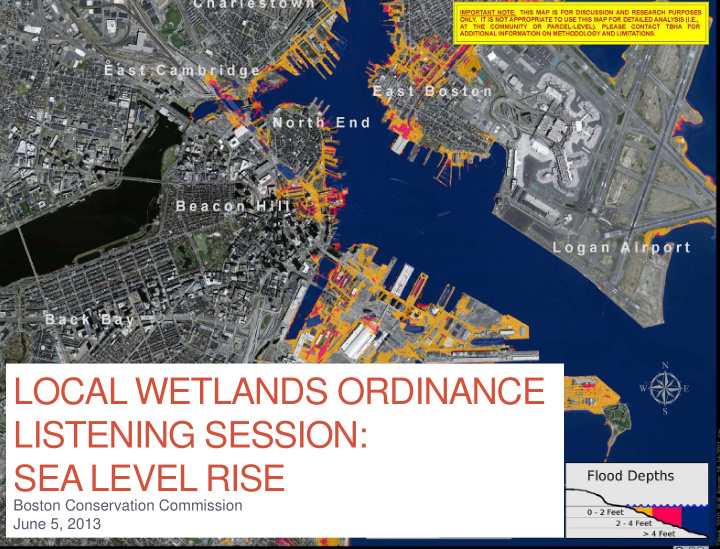



LOCAL WETLANDS ORDINANCE LISTENING SESSION: SEA LEVEL RISE Boston Conservation Commission June 5, 2013
Why do we need a Local Wetlands Ordinance? • Protect more resource areas • Protect existing resource areas to a greater degree • Consider how future conditions will affect resource areas
Why do we need a Local Wetlands Ordinance? • More than half of the 351 cities and towns in MA already have a LWO. • Of the 78 municipalities in the Coastal Zone, Boston is 1 of only 6 that does not already have a LWO.
What is happening? • Between the last ice age and a few decades ago, the rate of sea level rise (SLR) had been on average 10” per century. • The rate of SLR has been increasing, and is expected to increase globally between 0.2 and 2.0 meters (8” – 80”) per century. NOAA 2012 report “ Global Sea Level Rise Scenarios for the United States National Climate Assessment ”
How do we know what to plan for? • We should act on the best scientific consensus about sea level rise, as it exists today, knowing that forecasts will shift as each decade validates or causes modifications to our projections. Ranges of Projected Sea Level Rise by 2100 NOAA (2012)
How do we know what to plan for? In Boston, SLR may reach 4.5 - 7 feet by 2100, • and continue to rise for several hundred more years. In about 80-90 years...
How will this impact Boston? • Daily tidal inundation of low lying areas High Tide at Long Wharf November 2011
How will this impact Boston? • Significant coastal flooding of inland areas with storm events and associated storm surge UMass Harborwalk & Fort Point Channel during Superstorm Sandy, October 2012
How will this impact Boston? • Significant Erosion Columbia Point Shoreline Erosion Coastal Beach Erosion at Day Boulevard
How will this impact Boston? • Landward migration of wetland resource areas Wood Island Bay Marsh Developing tidal marsh at Bayswater Street Urban Wild
How will this impact Boston? • Permanent loss of land
Planning ahead… • Technology will allow us to more and more accurately predict the areas at risk of flooding and storm surge resulting from SLR years before they are actually impacted. • This means we have some time to plan, prepare and adapt. • We do not need to panic, but we do need to act now.
How can we protect resources as sea level rises? Current FEMA Floodplain Potential future storm flooding with SLR • Delineate future “Land Subject to Coastal Storm Flowage” instead of relying solely on maps of past storms. FEMA Special Flood Hazard Zone, aka LSCSF
How can we protect resources as sea level rises? • Create Performance Standards for Projects in LSCSF • Require buildings & structures to demonstrate an ability to function in an environment with higher sea levels without causing damage to wetland resource areas Sanitary sewer backflow devices prevents contaminated water from flowing back into The Spaulding Rehab Hospital was built high basements, protecting water above the floodplain with the mechanical suite on quality. Flood vents allow water to flow the roof. This reduces pollution and contamination caused by storm surges. through buildings, reducing waterborne debris.
Next Steps • Additional Listening Sessions: • June 19 th • July 10 th • Steering Committee will submit Guiding Principles for the Local Wetlands Ordinance to the Conservation Commission • The Commission will endorse them and submit them to Mayor Menino • The Mayor will direct staff to draft the ordinance • The Mayor will submit the ordinance to City Council • City Council will hold a public hearing
Questions & Concerns… http://www.cityofboston.gov/environment/Conservation/wetlands.asp stephanie.kruel@cityofboston.gov
Recommend
More recommend